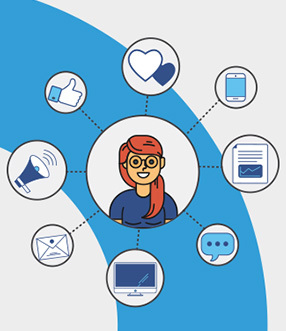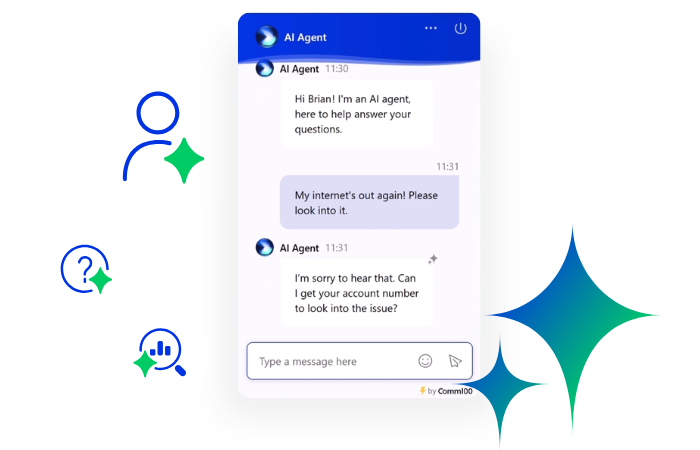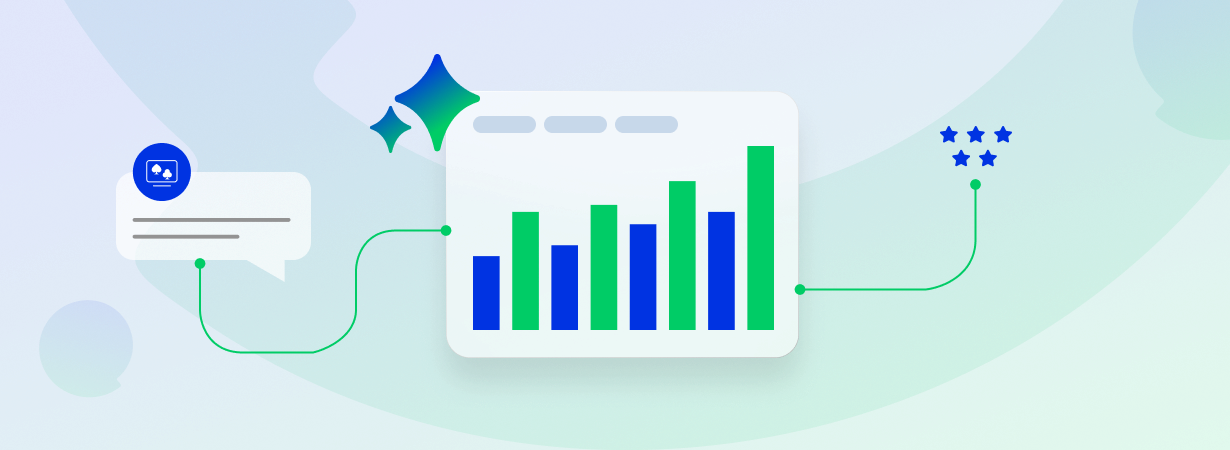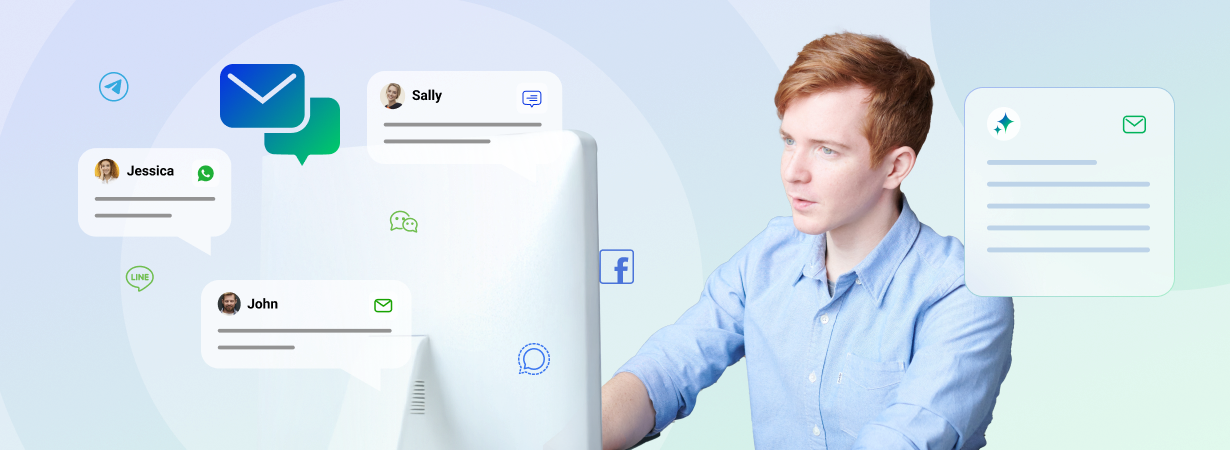It happens to many businesses. Imagine you’ve purchased what seems like the perfect customer engagement software for your company — the one that will take your customer relationships and revenue to the next level. At first you feel satisfied, confident in your investment. But as it turns out, the road to success isn’t without setbacks: Despite everything that this software provider promised, you begin to come across some unspoken — and unexpected — downfalls.
Maybe your customer engagement tool traps you in a price creep, a stiff contract, or forces you to purchase add-ons to get the full functionality that you thought was included. Maybe it’s missing some key features or isn’t as user-friendly as you had hoped.
Regardless of what the problem is, these pitfalls are at best annoying — at worst they can mean not getting proper use of the customer engagement software, or funneling money into an unsuccessful venture. Here are some of the hidden drawbacks of customer engagement tools that providers won’t tell you — and tips on how to avoid them when purchasing your software solution.
Here’s a quick glance at the pitfalls to avoid:
- Stiff Contracts Can Lock Companies In
- Hidden Costs Add Up
- All-in-One Systems Can Fall Short on Individual Capabilities
- Caps and Restrictions Hinder Engagement
- Watch Out for Key Differences Between Similar Solutions
- Overstated User-Friendliness Is Problematic for SMBs and Startups
- On-Premises Deployment Comes with Extra Costs and Limitations
- Companies That Misuse Systems or Cut Corners May Suffer
- Relying on a Single Customer Engagement Tool or Touchpoint Makes You Less Competitive
- Overbuying or Spending on Something You Don’t Need
- Free and Low-Quality Tools May Come at A Price
Stiff Contracts Can Lock Companies In
While some customer engagement solutions offer flexible monthly and per-use pricing, other providers may require an extended contract to use their services. Companies such as SugarCRM require companies to commit to annual contracts, making it hard to switch software or downgrade packages should you overbuy. That’s not all, though — SugarCRM also requires companies to purchase a minimum of 10 user licenses annually, putting their starting price at $4,800 per year (other software solutions may require an even higher user amount — SAP CRM requires a minimum of 15).
Some vendors try to lock businesses in by promising them the best rates for a longer contract: Salesforce encourages multi-year agreements in exchange for its most favorable pricing terms. While more extended contracts may not be a problem for companies who use the software year after year, it can be a deterrent for businesses who aren’t ready to commit to a long-term solution.
More than anyone, enterprises can come out affected by whether or not a software provider has inflexible contract negotiation practices. According to Gartner, one of the downfalls of both Salesforce and Oracle is that customers have given the companies “comparatively low scores for contract negotiations and pricing flexibility.” To help empower customers, Gartner, Snowforce data, and Medium have all written articles advising businesses on the best way to negotiate terms with Salesforce.
While stiff contracts aren’t necessarily a reason not to choose a customer engagement solution, being aware of this reality can help you better do your research and analyze the cost-benefit of software before committing to it.
Powerful live chat software
Offer real-time, personalized, efficient support that your customers and agents will love at 1/3 the cost of voice support.
Learn more
Comm100 Live Chat
Tips for avoiding this pitfall:
-
- While it’s essential for any agreement, businesses that are considering entering a long-term contract should familiarize themselves thoroughly with the pros and cons of a software solution before committing to it. This includes doing a cost-benefit analysis of the software, to make sure it’s really worth what the vendor is asking you to invest.
- Take advantage of the free trials that most customer engagement software vendors offer before committing to a stiff contract, so that you can make sure that this software solution really is the best choice for your company.
- Look at your 3-month, 6-month, and 12-month plan. Will agreeing to this software’s conditions help you achieve your goals for this time frame, or could it hinder growth? (How scalable is this software solution?)
- Start small wherever possible: you can always increase your contract duration if you decide that you like the software!
Hidden Costs Add Up
A big problem with customer engagement software providers is that many aren’t very upfront about hidden costs at the time of purchase – and hidden costs add up.
Here are some hidden costs to watch out for, along with a few examples of companies that have charged these hidden costs:
- Paid add-ons (Salesforce) — The need to pay for add-ons to get the most out of Salesforce makes it fairly inaccessible to startups and small businesses.
- Paid reports (Hootsuite) — The fact that Hootsuite requires businesses to pay for additional reports can be an expensive speed bump for companies that are serious about monitoring their social media engagement.
- Paid technical support (HubSpot) — From troubleshooting to making changes to the software, paid technical support can add extra dollar signs to what was once an innocuous bill.
- Implementation costs (Salesforce) — From deployment to customization, Salesforce and other customer engagement software providers often charge an implementation cost that you won’t find on their website.
- Onboarding costs (InfusionSoft) — Okay, InfusionSoft was actually pretty upfront about this one, but not all software solutions are.
These aren’t the only hidden costs you should be aware of: you should also be on the lookout for unexpected jumps in pricing. Some companies like HubSpot have been criticized for their steep price creeps, meaning that as your requirements and contacts grow, so does the cost — and quite rapidly.
Remember that not every company or every plan has the same hidden costs, and that some are very minor when compared to the ROI that they’ll bring you. However, it’s still good to have a full picture of what those costs may be so that you can successfully analyze the cost-benefit of a software.
Tips for avoiding this pitfall:
- Consult with a sales representative and make specific pricing inquiries to ensure full, transparent pricing.
- Read comments and reviews about different companies and their plans to make sure that they don’t have any hidden costs that will surprise you down the line. Even if they do, this step will ensure that your company consents to and is ready to take on those costs.
- When comparing software solutions, make sure to consider the whole price, not just the price of the plan on the vendor’s website. The full price includes the cost of add-ons, deployment fees, and any extra costs you’ve come across in your research.
- Look at your projected business growth when deciding on a customer engagement software solution. It may be smarter to start out with a software provider that has a more expensive second-tier plan, but a more affordable enterprise plan if you expect your company to hit enterprise level in the near future.
All-in-One Systems Can Fall Short on Individual Capabilities
Let’s be honest — who doesn’t like the sound of an all-in-one system?
Many companies with a variety of software needs may initially opt for a one-stop-shop when it comes time to purchase a customer engagement solution. And these aren’t hard to find — with the customer engagement software market ever-expanding, many vendors advertise their brand as capable of delivering on several different areas of engagement.
While these offerings may seem compelling, all-in-one systems run the risk of being a jack of all trades, but a master of none. In other words, while all-in-one systems may offer many tools, the capacities of each individual tool may not be as strong as what dedicated vendors provide.
For example, HubSpot is an all-in-one software provider that offers CRM, marketing, and sales tools. While HubSpot has received praise for its inbound marketing solution, it’s CRM software isn’t as powerful as other dedicated CRM solutions such as Oracle or Salesforce. Another example is Zendesk. Zendesk is a great all-in-one help desk software, however, its live chat tool lacks the Enterprise features and functionality that expert providers like Comm100 offer.
The fact that all-in-one software solutions may not provide companies with the individual tool functionality that they need is no secret — vendors like Zendesk and HubSpot know this, which is why they offer integrations with third-party apps. That way, businesses can use the tools that these companies deliver best on, while turning to other providers for more advanced individual tool functionality.
When contracting an all-in-one software provider, be aware that you might have to spend extra in the future if the capabilities of their tools don’t fulfill your needs. It’s also important to note that despite having less powerful tools, all-in-one vendors often aren’t cheaper than dedicated providers — that’s because to “unlock” certain tools and features customers are often required to switch to a higher payment plan or pay an additional monthly amount per feature. While all-in-one vendors have a lot to offer customers, expecting or depending on them to fulfill every need your company might have can be a setup for disappointment.
Tips for avoiding this pitfall:Make a list of the customer engagement tools that your company is looking to invest in. Then, on a scale from 1-10, rate how important it is that each of these tools have advanced functionality (if you know which specific capabilities you want out of each tool, be sure to jot those down as well). This will help you sort out your non-negotiables from your negotiables so that you can more easily decide what functions to invest in a leading provider vs. leave to an all-in-one vendor.
Caps and Restrictions Hinder Engagement
There are many kinds of caps and restrictions that could hit your company when purchasing a customer engagement solution. One of the most common and transparent ways that software providers manage restrictions is through pricing tiers. Pricing tiers often correspond with different business sizes and starting levels (for example, MailChimp’s subscription plans are named Forever Free, Growing Business, and Pro Marketer, after who they’re geared towards). Free versions of software typically have the most caps and restrictions, making them hard for companies to use beyond an introductory level. The rule of thumb is the more a business pays, the fewer restrictions they face and the more features they unlock.
Having greater restrictions on cheaper pricing plans is standard among SaaS providers and isn’t always a downside to the software solution: the inclusion of less feature-rich packages keeps prices low for smaller companies that don’t need them. That being said, it’s important that you check out exactly what features are included in different pricing plans so that you won’t be disappointed if your favorite features aren’t part of the bundle.
Companies may boast their integration abilities, but watch out: integrations are also prone to restrictions. If you’re banking on a software solution integrating with your current CRM or social media tool, be sure that the integration is included in the pricing plan that you’re interested in.
It’s not just features or integrations that come with restrictions: some customer engagement software providers will even restrict engagement depending on how much you pay. For example, CRM software solutions like Salesforce may not allow lead assignment and routing unless businesses to upgrade to at least a second-tier plan; marketing solutions like MailChimp may only allow so many email automations or subscribers. Engagement solutions like Hootsuite that charge per plan and not per user can greatly restrict how many users companies are allowed. Even live chat providers often put caps on the number of chats that companies can send monthly from lower paying accounts (don’t worry, Comm100 doesn’t do this!).
Tips for avoiding this pitfall:
-
- The good news is that caps and restrictions will normally be listed on the software vendor’s website alongside the pricing plan. To avoid being affected by annoying caps and restrictions, make sure that your software of choice offers the functionality and integrations that you need as part of the pricing plan that you’re willing to invest in.
- If the features that you’re interested in aren’t listed under the pricing plan, search for these specific features on the company website — the page promoting that feature should tell you what pricing tiers it is included with.
- Should the pricing plan that you’re interested in have too many restrictions, you can avoid them by investing in a more expensive plan and/or by researching different software solutions. Enterprise level accounts generally offer the most robust functionality with the least restrictions.
Watch Out for Key Differences Between Similar Solutions
It’s not just about caps and restrictions — some customer engagement software vendors don’t offer as many features as their competitors, regardless of the price plans. And what’s missing can often go unnoticed: after all, you won’t find SaaS providers boasting the features they don’t have – they flaunt what they do.
Let’s take a look at live chat, for example. Some live chat providers such as SnapEngage and ClickDesk only collect data on visitors that have sent a live chat request, whereas Comm100 proactively collects data from all website visitors — regardless of whether they request to chat. The result is an extreme difference in reporting capabilities between these live chat solutions and Comm100 — a gap that many customers may not realize exists based on these providers’ websites alone.
A gap in reporting capacities isn’t the only example of key performance differences amongst live chat providers. Some live chat providers also penalize lower paying plans by providing them with fewer customization options, which can be hurtful to startups and small businesses. Others, like Velaro, don’t offer a remote desktop feature, which is useful in supporting customers. And others still lack audio and video chat capabilities – a feature which is available as an add-on from Comm100.
Sometimes similar types of solutions have different focuses that set them apart. For example, there are many kinds of social media solutions. Some, like Hootsuite, are more focused on marketing. Others, like Sprout Social, have a built-in social CRM. It’s important to be aware of these critical differences to pick the solution that will best fit your needs.
Tips for avoiding this pitfall:
-
- Compare the features of each product that you are considering side-by-side so that you will notice when products are missing a feature that is important to you.
- Pick a software solution with a focus/feature set that’s right for you, keeping in mind that this can vary significantly within the same product category.
Overstated User-Friendliness Is Problematic for SMBs and Startups
Many businesses believe customer engagement software providers when they say that their software solution is easy to use. However, expecting a tricky software to be user-friendly can result in complications down the line.
The consequences of a less-than-user-friendly software are felt most strongly by SMBs and startup companies with small budgets. That’s because software that is not user-friendly can have additional training and even hiring costs attached to it. For example, a product like Salesforce might boast that it is user-friendly, but then prove to be too complicated to use without hiring an administrator (and if you don’t have money in the budget for an administrator, then you’re out of luck).
In another pitfall scenario, you might hope that you will be technologically savvy enough to use a specific piece of software, but then have trouble adapting. If this doesn’t directly result in you investing more money, it will at least cost you time as you adjust to the learning curve (and as the saying goes, time is money).
But it’s not just small businesses that are affected by overly complicated software. Big businesses may want a solution that their team can adapt quickly to, or software that they can make changes to on their own. This is where engagement solutions like BoldChat become a problem – they require users to be versed in coding to make changes to the software, which alienates businesses that want a simple solution.
Tips for avoiding this pitfall:
-
- Read reviews of products online, specifically from businesses with a similar profile to yours. (Did other businesses of your size with your same financial situation and tech experience have a hard time using this product?)
- Ease of use can include many things — be sure to consider the following when researching a product’s user-friendliness: Is this product going to be challenging to learn or train your team on? How about to set up? Will it be demanding to maintain, or taxing to make changes to? Are there any simple tasks that this software complicates? Will it be easy to reach customer support should you need help with the software?
- Take advantage of free trials to test usability.
- More complicated does not always mean more powerful: when in doubt, choose the simpler solution.
- Once you contract an engagement solution, you’re not on your own – make use of any training, self-help resources, and other materials that the vendor may provide.
On-Premises Deployment Comes with Extra Costs and Limitations
As a leader in Gartner’s SFA Magic Quadrant for the 11th straight year, we can learn a lot from Salesforce. One of those things is that the cloud is the future of SaaS — which makes on-premises deployment a thing of the past.
Companies that rely on on-premises deployment have to wait for essential upgrades — some even see additional fees for upgrades, customization, or maintenance. Meanwhile, companies that opt for cloud-based deployment can receive updates, data backups, and more instantly — keeping them up to date with the latest software developments.
According to one study, 93% of organizations are now using cloud services. And the best cloud-based providers have robust security requirements that often trump the need to implement in-house — for example, Comm100 is ISO27001 certified.
Tips for avoiding this pitfall: Cloud systems have better data backup, faster implementation, require no additional IT resources to support your infrastructure for servers, networks, and applications. Any upgrades are received right away, so you can continue to perform at a high level with the latest software. Avoid the pitfalls of on-premises deployment by choosing the cloud.
Companies That Misuse Systems or Cut Corners May Suffer
Customer engagement software solutions have enormous potential when it comes to growing businesses — however, if businesses aren’t serious about implementing them, then this potential can go to waste. Some companies invest significant amounts in CRMs and other engagement software systems only to see them fail after six months. The reason why is an improper use of the engagement tool.
There are several ways that a company could fail to take advantage of their customer engagement software. Companies could fail to make serious use of reports that the software provides. They could fail to invest in a dedicated system administrator — something that is necessary for companies with CRMs such as Salesforce, Oracle, etc.
Or, they could fail to embrace the software. Forbes contributor Gene Marks recalls salespeople at one of his clients not taking Salesforce seriously, which when coupled with lax management ultimately caused the system to flop. As Marks says, “Don’t want to embrace your CRM? Don’t want to require a bare minimum of data entry to track customer contacts and key profile data?
Don’t care if a salesperson isn’t paying attention to the system? Then suffer the consequences. The most successful CRM systems are at companies where the system is the culture.”
Tips for avoiding this pitfall:
-
- Get critical reports sent to your inbox daily, weekly, monthly, etc. Use this data to manage employees and adjust engagement strategy.
- If you are looking to adopt a CRM, hire a dedicated CRM account administrator, or reorganize scheduling to create time for that person. Empower them to be the owner of that system. If you are taking on a social, marketing, live chat, or other software solution, make sure that whoever is in charge is well-versed in the system.
- Provide training on the new system — many software vendors make this easy by offering onboarding material and support. Make sure that salespeople, customer service agents, social media reps, or anyone else who is using the system understands it, and using it as they should be. Embrace the system and make it a non-negotiable part of company culture to do so.
Relying on a Single Customer Engagement Tool or Touchpoint Makes You Less Competitive
Especially if you’re a business on a budget, you might be compelled to pick a single customer engagement function and say goodbye to all the rest.
Maybe you just want to focus on marketing, and you aren’t interested in using customer engagement tools for customer service. Or perhaps you want to invest in a knowledge base, but you aren’t interested in connecting with customers over any other touchpoints.
Customer engagement software is an essential part of creating a frictionless, omnichannel customer experience. By meeting your customers across all channels with the help of a variety of applicable customer engagement tools, you will be putting your business in the position to better collect customer information, strategize, engage, and ultimately drive sales and customer loyalty.
Tips for avoiding this pitfall: For businesses who can afford to, it’s essential to invest in a multichannel, multi-tool approach to customer engagement. After all, your customers need to be cared for at all phases of their customer lifecycle to remain loyal, engaged brand participants. Just like how sales, marketing, and customer service work together on customer outreach — CRM, social media, marketing automation, live chat, knowledge base, and other engagement tools work in unison create a seamless buyer experience.
Overbuying or Spending on Something You Don’t Need
You don’t want to underinvest in your customer experience, but you also don’t want to overinvest. Customer engagement software providers will sell you on as much as they can — it’s up to you to know what’s vital to the success of your business, and what isn’t.
Tips for avoiding this pitfall:
-
- Don’t let vendors oversell you on a plan right off the bat — carefully consider the plan that would be best for your business. For example, if you have a limited budget and this is your first customer engagement software, you might want to start small. Give yourself time to organize and learn how to use the software without breaking the bank by starting with a more modest plan. If you aren’t sure of how many campaigns you’ll want to run (and other information that varies per plan), it never hurts to start with a smaller plan, and then upgrade. On the other hand, if you’re an enterprise with an experienced administrator and who can make use of robust features, it may best for you to go straight for the most customizable, option-heavy plan.
- When considering whether or not to purchase add-ons, ask yourself what products will be directly helpful to the growth of your business. Is there anything that you’re itching for that’s just attractive advertising rather than something that you’ll actually need or use? Would this add-on or feature benefit your employees or customers? Will it help put your business ahead of the competition, or do you just want it for the sake of having all the bells and whistles?
Free and Low-Quality Tools May Come at A Price
For small businesses and startups, affordable customer engagement tools are worth looking into as your organization takes off. However, for large companies and enterprises, these tools can come at a price.
According to CCW Digital’s latest Winter Report, the top priority for organizations going into 2018 is to create a frictionless experience for customers. When enterprises invest in low-quality customer engagement tools, they may fracture rather than build better relationships within and outside of their organization. Poor software tools can make it harder for employees to work as a team thanks to limited functions, user allowances, and disempowering permission restrictions. This can frustrate employees, and even influence a higher turnover rate.
Remember that the employee experience is directly related to the customer experience – employees that struggle to operate within the limits of a low-quality software can impact how satisfied customers are with a company. Low-quality engagement tools also fall short on delivering personalized service to customers, which is one of the most essential qualities that defines a customer-centric brand.
Some of the downsides to using a cheap customer engagement software may vary per solution. Spam-like messages from bad marketing automation software tools can drive customers away and into the arms of the competition. An unattractive, poorly customized live chat window can look bad on your company’s otherwise professional website.
Poor reporting capacities, limited customization options, and weak tools can all be signs of an inflexible software that can cause a lasting headache for your organization, and make it harder for you to analyze or adjust your current strategies. Basic systems can fail to collect the customer data needed to create a smooth multichannel user experience.
For enterprises, lower quality customer engagement tools can reflect poorly on your business. If you aren’t willing to invest in quality customer engagement solutions, why should customers invest in your product?
For startups and small companies on a budget: don’t forget that free and low-quality customer engagement tools are packed with restrictions that can limit even the smallest business. Remember what many software providers are ultimately intending when they offer free tools: to give you a taste of what their software provides while limiting how much you can actually reap the benefits of it. This forces growing companies to upgrade their software solution, or be content with getting little to nothing out of the software.
Tips for avoiding this pitfall: Before contracting a free or inexpensive software provider, ask yourself the following:
Are they going to have all of the basics you’d take for granted in enterprise tools (e.g. security?) Is their engagement software well supported enough to be business-ready? And what happens if development of the tool gets abandoned? (This is probably less likely when adopting an established paid solution with a strong team/business model behind it.)
Conclusion
If you are new to customer engagement software, consider implementing one solution at a time, so that you don’t overwhelm yourself. Take time to learn the systems, perform proper training, and pave the way for growth.
No customer engagement tool is perfect. Expecting that you’ll find a customer engagement software without a single setback is a pitfall in itself. However, with a bit of time, patience, and research, you will be able to find the best tools for engaging with customers, gathering data, automating your marketing, and everything in between.
For more reading, check out our blog post, How to Set Goals & Build a Strategy to Drive Customer Experience Improvement.
Download now: Everything You Need to Know About Customer Engagement Software
This eBook will help you to learn about typical software solutions, categorize them according to your needs, understand typical benefits and pitfalls, and it also comes with a handy checklist to guide your final decision.
Download Now
eBook








